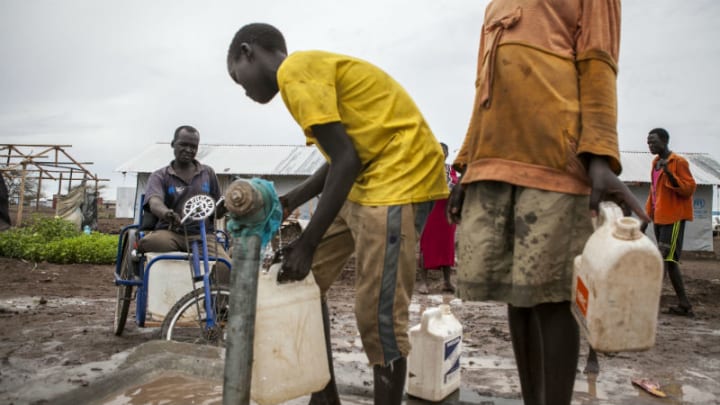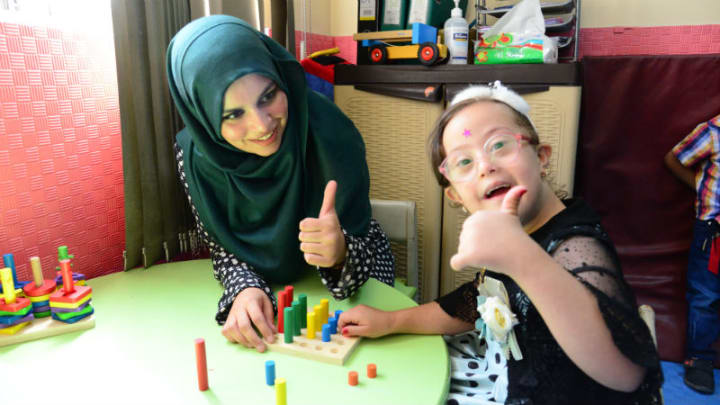
BARCELONA — This month, the United Nations launched its first guidelines to tackle the exclusion of people with disabilities in humanitarian action.
While advocates said the move was long overdue, they added that several key steps remain to ensure they are put into action.
The guidelines were developed by a task team within the Inter-Agency Standing Committee — the U.N. mechanism for coordinating humanitarian assistance — as well as people with disabilities, civil society, and humanitarian stakeholders. They are intended to supplement the Charter on Inclusion of Persons with Disabilities in Humanitarian Action, which launched in 2016.
“We’re not asking for a favor. This is a right of people with disabilities.”
— Nujeen Mustafa, Syrian refugee, author, and activistActions recommended for humanitarian organizations include recruiting more people with disabilities — including as front-line workers — partnering with organizations that represent people with disabilities, training humanitarians to recognize barriers and design inclusive programs, and collecting more data on disability to monitor equal access.
It comes at a crucial time and will help humanitarian actors adopt a shared understanding of what disability-inclusive humanitarian action looks like, said Charlotte Petri Gornitzka, deputy executive director at UNICEF — a member of the task team alongside the International Disability Alliance and Humanity & Inclusion.
“Estimates suggest more than 20 million persons with disabilities are impacted by conflicts and natural disasters globally. Children with disabilities are at higher risk of abuse and neglect during humanitarian crises, for example, and women and girls with disabilities are at higher risk of sexual violence,” she said.

In some cases, it has been reported that people with disabilities are four times more likely to die in a disaster than those without disabilities.
Calling the guidelines a step in the right direction, Nujeen Mustafa, a Syrian refugee, author, and activist with cerebral palsy, said it’s one that should have come sooner. “We’re not asking for a favor. This is a right of people with disabilities. You can’t say ‘it’s too expensive’ [to provide equal access to basic services in a crisis]. That’s laziness,” she said.
To see practical results, though, the first step will be getting donors to make disability inclusion compulsory, argued Florence Daunis, director of operations at Humanity & Inclusion.
Some donors, such as the U.K. Department for International Development, the German Corporation for International Development, and the European Union, already have a recommendation marker on how disability is included in the projects they fund, but many others do not.
It will then require training for staff, including frontline staff, and partners. “We need to make technical expertise available, pushing NGOs to have an agreement to work with organizations of persons with disabilities to help them understand what it means, and try to have an interconnection with gender and protection experts,” Daunis said.
Some organizations have already begun planning their adoption of the guidelines, Gornitzka said. And Daunis believes it won’t be too big an ask for others to do the same.
“A lot of people think this is about specific needs related to health, [or that] it’s so complex, or [that it’s] going to take time, but that’s definitely not the case,” she said. “Don’t be afraid to take this on board. It’s easy to do. It’s only a matter of changing your scope or lens.”
For instance, instead of announcing food distribution in a camp via a megaphone, it’s thinking about how else this can be communicated for people who may be deaf, she added.
Ann Koontz, Relief International's senior vice president for technical assistance, said although they already employ frontline workers with disabilities and work with partners that specialize in disability and inclusion, they are exploring ways in which the guidelines can help improve and enhance those efforts.
“My main takeaway from the report is that not all disabilities are visible or 'packaged' into one issue or source. We need to listen closely to the individuals' issues and provide solutions that, when possible, are customized to meet their needs,” Koontz said.
For example, in Jordan's Zaatari camp, Koontz explained that the effects of PTSD and bedwetting had not been factored into water allocation and resulted in an undersupply because of the increased amount of daily washing and water usage. Considering such needs would enable Relief International and others to better provide basic services for those with physical disabilities and mental health issues, as well as the broader population in humanitarian need.




